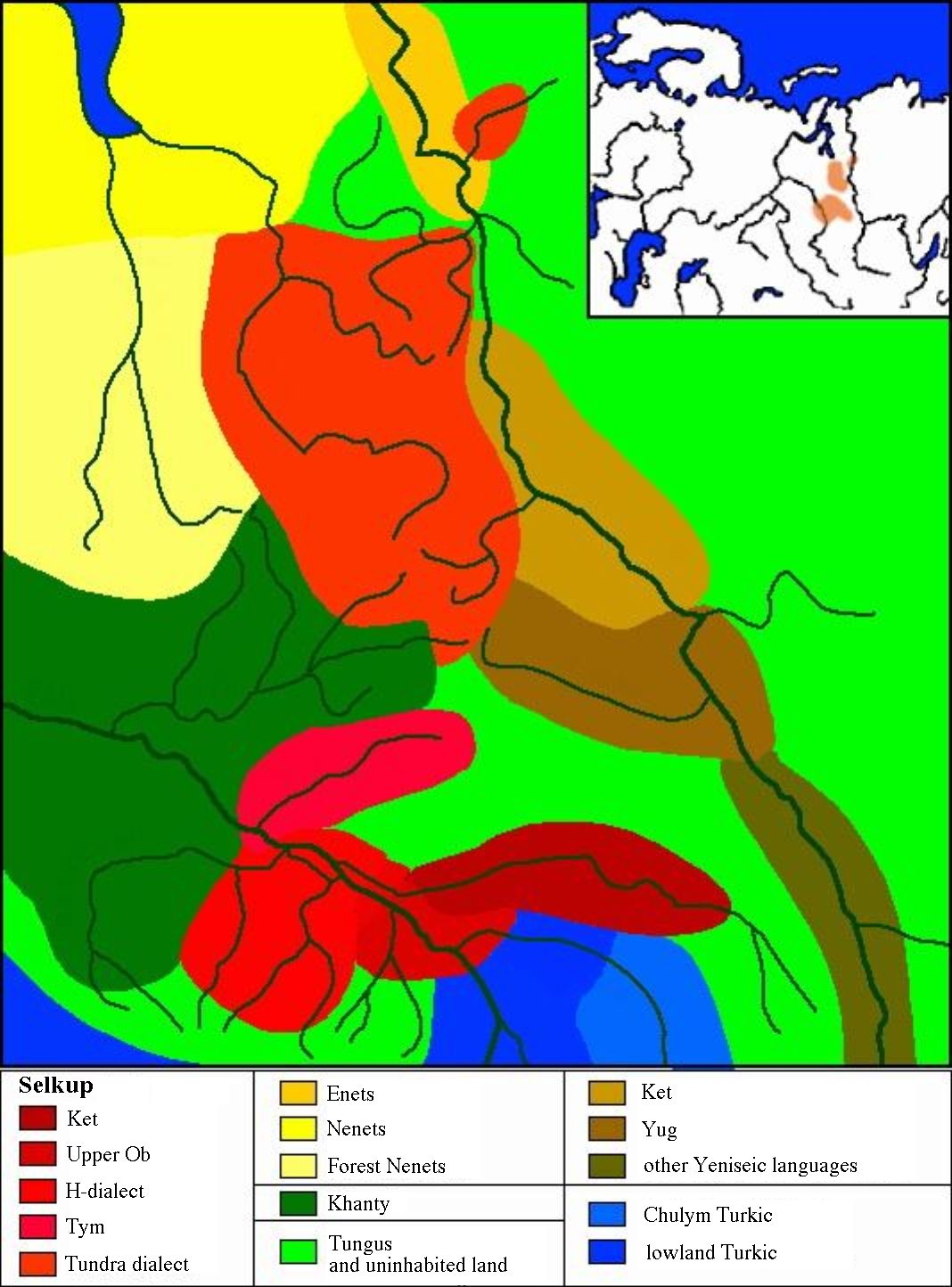Selkup Dialects

Selkup area with neighbouring peoples
Selkup dialects with Castrén’s sources
Tym Two pages of words 156–157, written down while Castrén passed the mouth of the Tym River on his journey to Narym in 1845 (Castrén’s first records of Selkup). Also, on page 51 Tym equivalents for six words are given.
N Narym, Castrén’s main dialect. Written down in the town Narym in September–December 1845. No information is given of where the informant(s) came from (as is the case with the other dialects).
Nm Another h-dialect informant, occasionally appearing in the N grammar and in the first word list, but not in the second. In GSL p. 426 is mentioned a “subdialect” (“dialekt-brytning”) having the possessive plural marker i instead of the ni of N, obviously meaning Nm. The rare word Nm čehai ‘roof’ from the first word list, is in the second word list labelled MO, which, if not a plain copy error, could point to Nm being the Parabel informant mixed into MO. Also, in the phonetics it is written that “c comes instead of č above Narym” (next line: ‘ds often comes in Nm’). It seems that some of the Nm words have been relabelled MO in the second word list.
SD Common form for several southern dialects. Also used in mixed lists, when the dialectal affiliation of the word cannot be established.
Ob Ivankino dialect of the texts. Recorded in Togur in January 1846. A word list to the texts is on pages 153–156. No grammar, the dialect is only occasionally mentioned in the first word list, as ‘Ob’.
MO An informant obviously from Čaja. Working beside the K informant, and also during the writing of the Ivankino texts. The word-list material contains words from other dialects, of which one is an h-dialect (at the beginning of the second word list ‘MO’ is said to contain “Middle Ob, Čaja, Parabel”). These seem to be Nm words, relabelled for the second word list.
Č Čulym. Used for the first informant (Castrén: Tsch. or Tschl.), and also for both informants, when it is impossible to determine which one is in case. [Note: Lehtisalo falsely interpret the variant ‘Tsch.’ as meaning ‘Čaja’.]
OO Upper Ob (Castrén: ÖO), another Čulym dialect informant. On page 339 appears a label ‘ÖOb’, which perhaps means a different informant. Č and OO were recorded jointly in the village of Molčanovo in February 1846.
K Lower Ket. Recorded in Togur in January 1846 (this informant is probably the one referred to in the Reiseberichte p. 156).
NP Upper Ket (“Natsko-Pumpokolsk”), recorded in Makovskoe in April 1846 on a two-week side journey from the Yenisei. The paradigms (unfortunately very scarce) are written in the right column of the Čulym paradigms.
Jel. Eloguj, southern Tundra idiom, recorded in Verhne-Imbatsk in May–June 1846 (Reiseberichte p. 258), separately from the other Tundra dialects. Pages 349-360 feature a short vocabulary and a very short grammar. In the word lists only a few other words are marked as appearing also in Jel., so no other material from this informant has been collected.
TD Unspecified Tundra dialect (B, Taz or Kar.)
B Baiha, Castrén’s main Tundra dialect, recorded in Turuhansk in June–July 1846.
SQNK The translation of the first poem of the Kanteletar into Baiha (and Taz) Selkup (manuscript among the Khanty materials. Analyzed in Hartmut Katz: Selcupica III. München 1986.)
Taz Several informants from Taz, impossible to distinguish from one another (Reiseberichte p. 261: from “Pókolgy, Karalg, Schirta, Ratta”). Recorded in Turuhansk in June–July 1846 (and possibly also on the three-day return in January 1847). From these informants Castrén has written down short texts, and example sentences. The different informants are marked 1., 2., 3.
TazTK Pages 391–393 (labeled “Tas (Tymsko-Karakonsk)”), informant with preserved č.
TazTexts The four short Taz texts on p. 463–465.
Kar. Karasino, northern Tundra idiom on Yenisei. Recorded in Turuhansk. A very short separate grammar, otherwise in the right column of the Taz grammar.
Kar2 In the second word list appear words written afterwards in light style, of more archaic form. These hardly represent new data recorded but are instead probably artificial corrections by Castrén.
